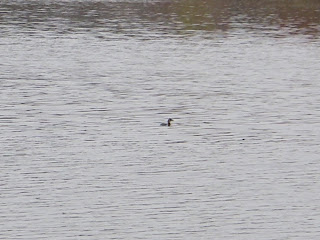This morning was perfectly calm -- not a bit of wind to ripple the water -- and warm. Despite a full cloud cover, the sky was bright. Birds must have loved the weather, as I had a bird-filled morning. (Birds... one thing for which my point-and-shoot camera, carried in a pocket and pulled out discreetly during class, is really inadequate.)

This coot was swimming in the pond this morning, along with several mallards, one of whom is reflected in the water at the top of the photo.

Red-wind black birds were out in huge flocks, and very talkative. Their calls sound like March to me, if March can have a sound, although obviously theirs is a spring arrival announcement AND a fall going-away call.

That little duck-shaped dot in the center is a grebe. I spent some time watching them go under and re-appear in different places. I could watch diving ducks for hours as they disappear and pop back up. First grade students, though, have about 3 minutes of duck watching in them. (Also note: by late morning, the water is less mirror-like and the wind is causing a bit of a chill...)

I saw 4 herons this morning, but none in such a strange position as this fellow, who actually camouflages perfectly with the roof upon which he is perched.
Other bird sightings this morning, which went unphotographed: a bluebird, on a bluebird box, looking grayer than usual, but still definitely blue. And a bunch of LBBs, goldfinches, etc.
In the non-avian world, these things were all over the edge of the pond. I suspect they are frog eggs, which may not make it, as they are on the shore. The lake levels were very high last week with all the rain we've gotten and are starting to recede. I guess these almost future frogs got stranded. (Anyone know more about what these are? Let me know!)
This is our car katydid from yesterday. It was on the windshield. So cute.


Your frog eggs look like a type of cyanobacteria known as Nostoc. I’ve got a terrestrial type that grows here in Southern Ohio, but I’ve seen types identical to what you’ve shown. I posted about my Nostoc last month. Links don’t seem to work from comments, so I’ve included the address if you care to have a look. http://bluejaybarrens.blogspot.com/2009/09/nostoc.html
ReplyDeleteThat heron is quite the thing. And now I've added Phenology to my vocab. Thanks!
ReplyDeleteThanks for the info! I've never heard of Nostoc; I read your post... now here's my next question. Why were mine all round but yours were flatter and irregularly shaped? Is this a different variety? Is it something to do with conditions during growth?
ReplyDeleteThere are many species within the genus Nostoc. They can be found in diverse habitats ranging from open water to dry upland sites. Those that grow suspended in water take on the spherical form, while those open air species grow as more of a surface film.
ReplyDelete